Abstract
Cavity optomechanics has recently emerged as a new paradigm enabling the manipulation of mechanical motion via optical fields tightly confined in deformable cavities. When driving an optomechanical (OM) crystal cavity with a laser blue-detuned with respect to the optical resonance, the mechanical motion is amplified, ultimately resulting in phonon lasing at MHz and even GHz frequencies. In this work, we show that a silicon OM crystal cavity performs as an OM microwave oscillator when pumped above the threshold for self-sustained OM oscillations. To this end, we use an OM cavity designed to have a breathing-like mechanical mode at 3.897 GHz in a full phononic bandgap. Our measurements show that the first harmonic of the detected signal displays a phase noise of ≈−100 dBc/Hz at 100 kHz. Stronger blue-detuned driving leads eventually to the formation of an OM frequency comb, whose lines are spaced by the mechanical frequency. We also measure the phase noise for higher-order harmonics and show that, unlike in Brillouin oscillators, the noise is increased as corresponding to classical harmonic mixing. Finally, we present real-time measurements of the comb waveform and show that it can be fitted to a theoretical model recently presented. Our results suggest that silicon OM cavities could be relevant processing elements in microwave photonics and optical RF processing, in particular in disciplines requiring low weight, compactness and fiber interconnection.
1 Introduction
Cavity optomechanics addresses the interaction between light and mechanical waves confined in a cavity [1], [2]. When properly controlled, this interaction can give rise to a plethora of intriguing phenomena such as quantum ground-state cooling [3], phonon lasing [4], [5], optomechanically induced transparency [6], [7] or non-reciprocal behavior [8]. Amongst the different technological platforms implementing optomechanical (OM) cavities, their realization in planar photonic integrated circuits enables to accurately design the optical and mechanical resonances, as well as to maximize its interaction strength (given by the OM coupling rate, g0). This has led to OM cavities lithographically defined on released high-index nanobeams – the so-called OM crystals [9] – with mechanical frequencies reaching up to several GHz.
Since the mechanical vibration can efficiently modulate the intensity of an input optical signal, OM cavities could play a role in microwave photonics, a discipline that addresses the processing of microwave signals in the optical domain [10]. In this sense, some experiments have shown the performance of OM cavities as radio frequency (RF) down-converters [11] or OM oscillators [12], which are essential functionalities in microwave photonics. Moreover, since OM cavities are nonlinear elements, multiple harmonics of the fundamental mechanical vibrations can be over-imposed on the optical signal [11], [13], [14], a phenomenon that has been recently interpreted theoretically as an optical frequency comb (OFC) [15]. Notably, recent experiments have also shown that OFCs generated by Kerr nonlinearities could also play a role in the processing of microwave signals in the optical domain [16].
In this work, we first demonstrate an OM cavity on a silicon nanobeam having a breathing mechanical mode vibrating close to 4 GHz with a high g0 and placed in a full phononic bandgap. Then, by driving the cavity with a blue-detuned laser we demonstrate phonon lasing of this fundamental mechanical mode. We measure the phase noise of the generated microwave tone and show that the cavity can perform as an OM microwave oscillator. Stronger pumping of the cavity leads to the generation of a series of harmonics forming an OFC whose phase noise degrades with the harmonic number as in standard harmonic mixing. We also perform real-time measurements of the temporal traces that show a good agreement with a theoretical model of an OFC. This confirms that OM cavities can be used for the generation of OFCs with GHz-scale line spacing and may find application as ultracompact and lightweight processing elements for microwave photonics.
2 A one-dimensional (1D) OM crystal cavity with a full phononic bandgap
OM crystal cavities can be created on suspended silicon nanobeams with one-dimensional (1D) periodicity. The key idea is to have OM mirrors (that prevent leakage of both photons and phonons) on each nanobeam side whilst the main parameters of the periodic structure (such as the period or the size of the holes) are adiabatically changed toward its center to allocate confined modes. Moreover, the cavity has to be designed to ensure a good overlap between the optical and mechanical resonant modes to produce a sufficiently large g0.
One of the most popular 1D OM cavities in silicon nanobeams [17] consists of a series of elliptic holes whose size and axial ratio is adiabatically modulated. This OM cavity exhibits values of
Having a full phononic bandgap in a 1D silicon nanobeam requires making lateral corrugations in addition to the holes [18]. Using this approach, the existence of mechanical modes in a full phononic bandgap of a 1D OM crystal consisting of circular holes and lateral wings was demonstrated [23]. However, the mechanical modes within the bandgap in the cavity demonstrated in a study by Gomis-Bresco et al. [23] exhibit low
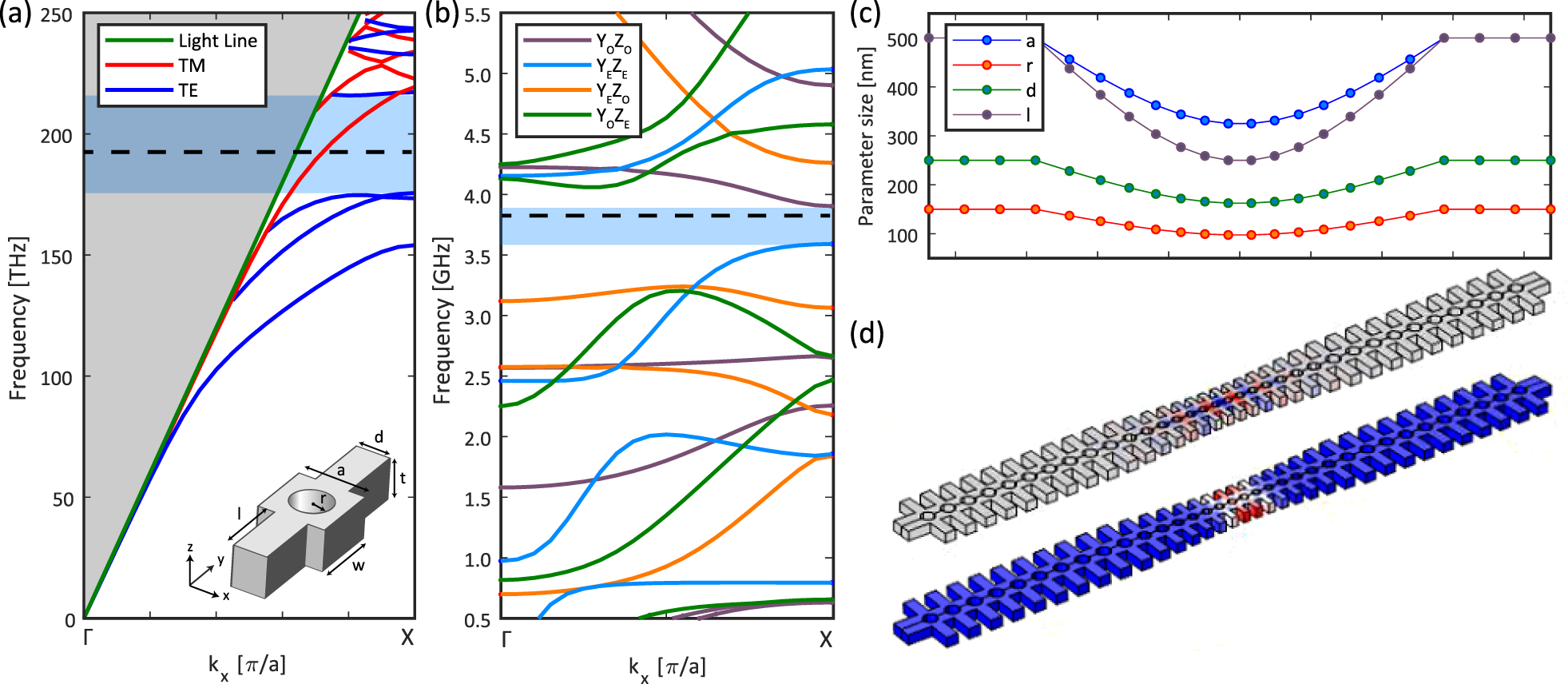
Design of a one-dimensional (1D) optomechanical (OM) crystal cavity with a full phononic bandgap.
(a) Photonic bands for transverse electric (TE-like) modes and transverse magnetic (TM-like) modes for the mirror unit cell. The gray- and light-blue-shaded areas denote the non-guided modes and the TE-like quasi-bandgap, respectively. (b) Phononic bands for mechanical modes with different symmetries for the mirror unit cell. (c) Parameter variation to build the OM cavity for the nominal structure. (d) Optical resonance at
A set of OM cavities was fabricated following the design summarized in Figure 1. Because of fabrication imperfections, the fabricated structures were a bit different from the nominal ones. Regarding the mechanical properties, fabrication imperfections may eventually lead to structures in which the mechanical breathing mode is no longer confined within the mechanical bandgap. To determine whether the fabricated structures also displayed a full phononic bandgap, we simulated numerically an OM cavity using the exact dimensions retrieved from scanning electron microscope (SEM) images, as that shown in Figure 2a. This was done by using a software that enabled us to convert the SEM image into a COMSOL schematic with the unit cell shown in Figure 2d. We simulated different unit cells in the mirror region of the cavity, and the final phononic band diagram is presented in Figure 2c. It can be seen that the full mechanical bandgap remains in the fabricated sample. We also simulated numerically the optical properties of the fabricated sample and obtained an optical mode well localized in the defect region and having an intrinsic optical Q factor
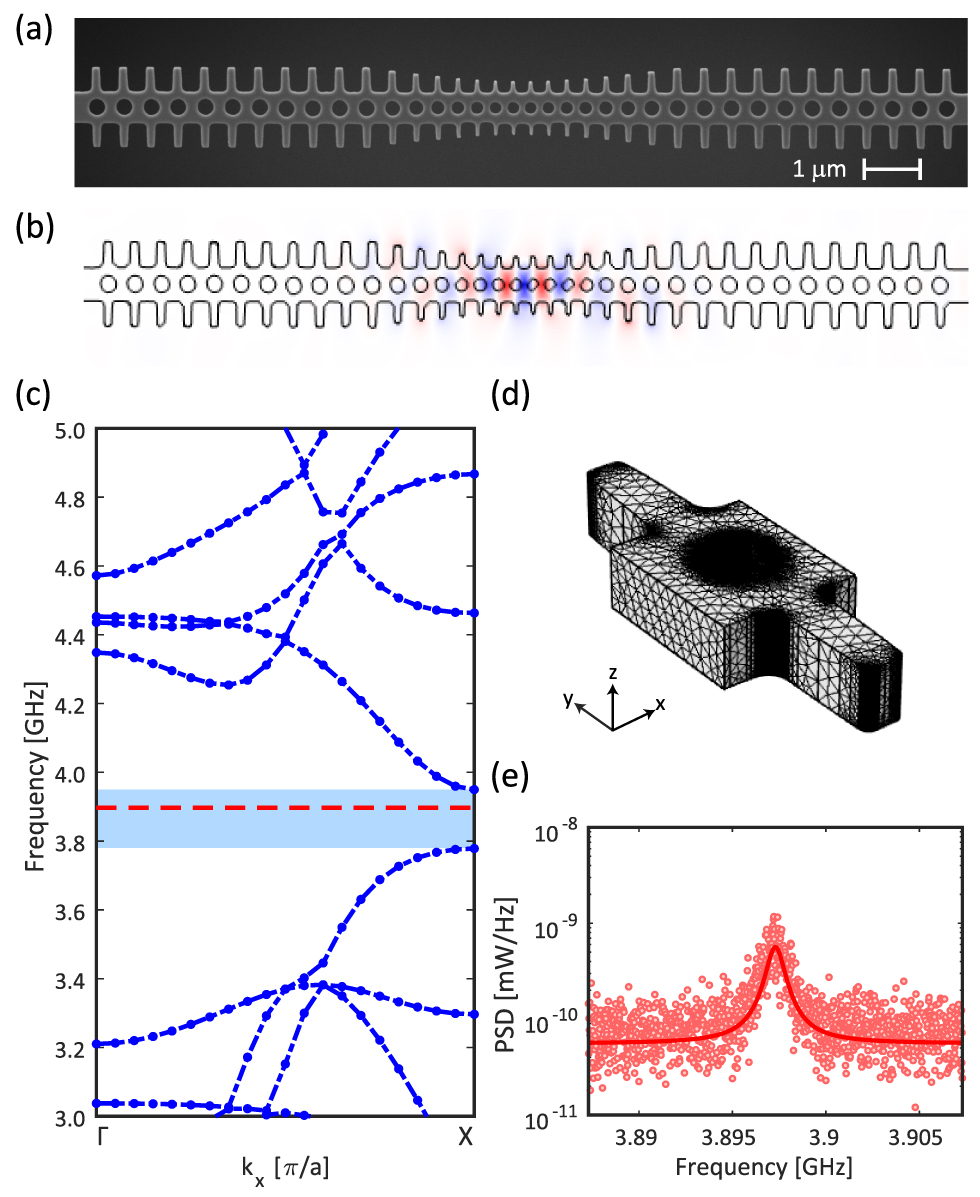
Optical and mechanical properties of the fabricated optomechanical (OM) cavity.
(a) Scanning electron microscope (SEM) image of the fabricated OM cavity used in the experiments; (b) field pattern of the localized optical mode in the fabricated cavity at a theoretical value of 1521.8 nm, very close to the experimental
Experimental measurements were performed at room temperature and at atmospheric pressure by coupling the light into and out of the cavity with a micro-loop fiber taper (see Supplementary material). Regarding the optical properties, the tested unheated OM cavity had an optical resonance at
3 Optomechanical microwave oscillator
High-quality microwave sources with ultra-narrow linewidths are required for a great variety of applications. Typically, microwave oscillators are made by applying frequency multiplication to an electronic source. This requires a cascade of frequency-doubling stages, which means that the power of the final signal is greatly reduced. Recently, different techniques to produce microwave tones via optical means have been proposed. The resulting device is called an optoelectronic oscillator (OEO) [28], [29].
Amongst the different techniques to build an OEO, stimulated Brillouin scattering has proven itself to be extremely useful since it can provide high-frequency RF signals with extreme purity (or extremely narrow linewidth). For instance, cascaded Brillouin scattering on a high-Q silica wedge cavity enabled the synthesis of a 21 GHz microwave tone with a record-low phase noise floor value of −160 dBc/Hz [30]. Owing to the equivalence between Brillouin scattering in a waveguide and OM interaction in a cavity [31], we could think that an OEO can be also obtained from an OM cavity when pumped with a blue-detuned laser source. In this case, since the involved mechanism is a self-sustained oscillation originated from OM interaction, from now on we will refer to it as an optomechanical oscillator (OMO).
In an OM crystal cavity, blue-detuned driving gives rise to a change of the mechanical frequency (the so-called optical spring effect), as well as reduction of the overall mechanical damping rate
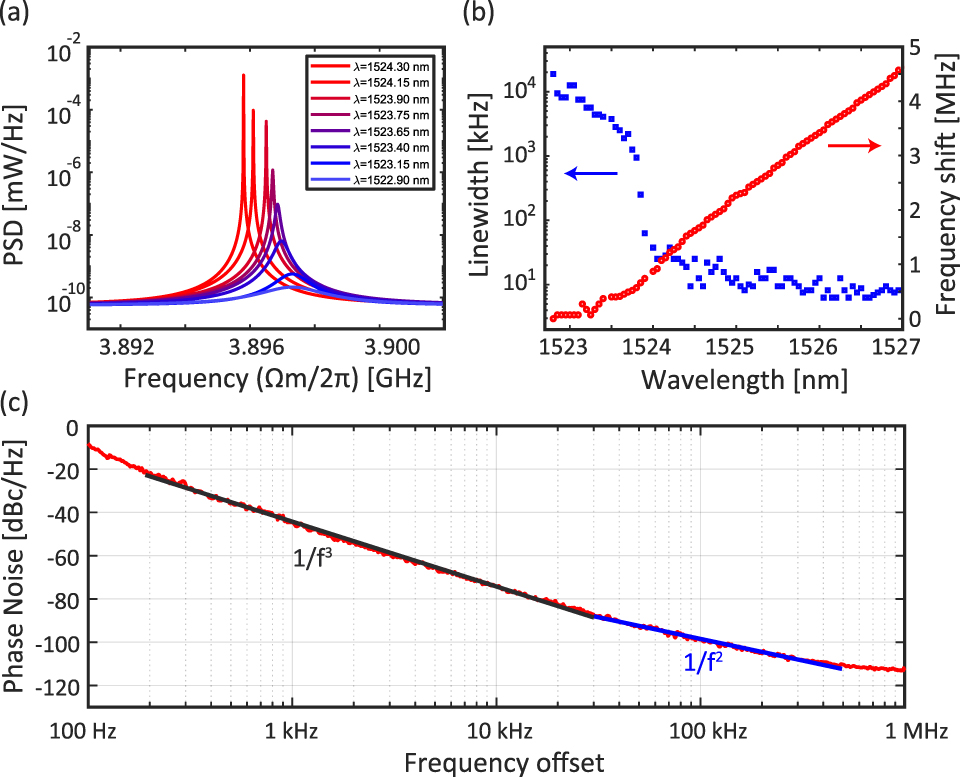
Driving the optomechanical (OM) crystal cavity to the phonon lasing regime at
(a) Detected RF spectra at different driving wavelengths
Once the mechanical resonance was self-sustained and the device entered the phonon lasing regime, we measured the phase noise of the generated microwave tone at
Noticeably, the phase noise becomes as low as (−100 ± 1) dBc/Hz at 100 kHz, which is a remarkable good value for a nanoscale GHz microwave oscillator. This performance is on par with some commercial mid-range devices, such as the Agilent N5183AMXG that displays a phase noise of −102 dBc/Hz at 100 kHz offset for a 10 GHz frequency [37]. In order to establish a fair comparison with other OMOs, we have calculated the equivalent phase noise at 100 kHz for a 5 GHz carrier frequency using the transformation
Comparison of the phase noise of different OMOs.
| References | Structure | fRF (GHz) | Phase noise at 100 kHz (in dBc/Hz) | Foot-print | Equivalent phase noise at 5 GHz |
|---|---|---|---|---|---|
| [35] | SiN ring resonator | 0.042 | −120 | −78 | |
| [12] | 1D III/V OM photonic crystal cavity | 2.92 | −87 | −83 | |
| [39] | Si 2D photonic crystal cavity | 0.112 | −125 | −92 | |
| [38] | MEMS oscillator | 1.12 | −107 | −94 | |
| This work | 1D Si OM photonic crystal cavity | 3.87 | −100 | −97 | |
| [30] | Silica disk | 21.7 | −110 | −122 |
OM, optomechanical; 1D, one-dimensional; 2D, two-dimensional; OMO, optomechanical oscillator.
4 OM frequency comb
At even higher driving powers, and always operating with the laser blue-detuned with respect to the optical resonance, higher-order harmonics can be observed in the detected signal. The underlying process is similar to cascaded Brillouin scattering in an optical waveguide [40]: the Stokes and anti-Stokes photons (resulting from photon–phonon scattering from the laser source) become new pump signals that generate new Stokes and anti-Stokes photons via photon–phonon interaction, and the process is repeated over and over as long as the resulting photons can propagate in the medium (Figure 4a). This process can become extremely efficient in an optical cavity supporting both optical and mechanical whispery-gallery modes (WGMs) if the mechanical frequency equals the free-spectral range [30]. In this case, there is a strong resemblance with the formation of OFCs in traveling-wave cavities as a result of third-order nonlinear interaction: the large density of states at resonant frequencies gives rise to a set of equidistant frequency lines at the output (Figure 4b).

Generation of harmonics and optical frequency combs (OFCs) in photonic structures.
(a) In an optical waveguide, a cascaded Brillouin process gives rise to a set of harmonics spaced
The generation of multiple harmonics in an OM cavity operated in the unresolved sideband regime inherits features of both effects (Figure 4c). First, the cavity linewidth is not so broad as in the case of the waveguide, but the high density of states around the resonant frequency benefits the underlying OM interaction. In comparison with the WGM cavity, the OM cavity do not support multiple optical modes exactly spaced by the mechanical frequency, which greatly relaxes the conditions to get multiple harmonics. This way, in the output optical spectrum we expect a series of peaks at frequencies
Since all generated photons are resonant within the same optical mode (Figure 4c), the number of optical carriers forming the OFC is limited by the linewidth of the optical resonance. As suggested in a study by Miri et al. [15], a cavity in the unresolved sideband regime should therefore provide wider OFCs than a cavity operating in the sideband-resolved regime. OM-generated OFCs have been previously observed using MHz-scale mechanical modes [25], [35], [39], [43]. In this case, a high-Q cavity with a bandwidth ≈1 GHz (Q > 105) can perfectly allocate a large number of harmonics. However, if we want to build an OFC from a GHz-scale fundamental harmonic, the Q factor of the cavity should be reduced to allow the build-up of a sufficient number of harmonics. In our case, the measured loaded optical Q factor, which satisfies the criteria in a study by Miri et al. [15] to produce an OM–OFC with a spacing equal to
To perform the experiment, we blue-detuned our laser and recorded the detected RF spectra under different input powers. For an input power of Pin = 3.38 mW, we reach the threshold for the phonon lasing, when
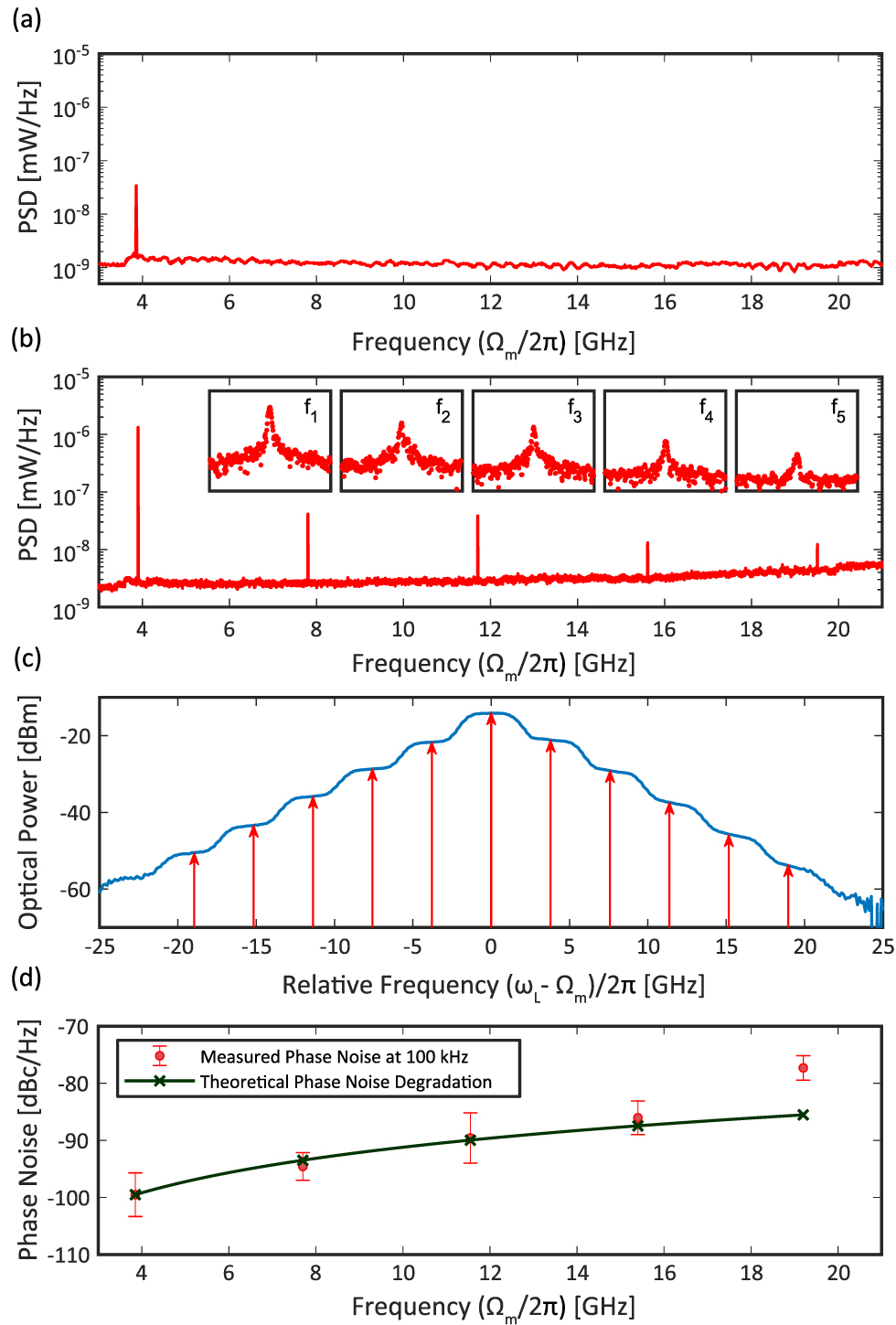
Optical frequency comb (OFC) generation in the OM crystal cavity at Pin = 3.38 mW.
(a) Detected RF spectrum above the phonon lasing threshold at
We also measured the phase noise of the different harmonics, as shown in Figure 5d. In principle, the harmonic mixing process will result in an added phase noise of
In addition, we studied the optical traces of the generated OFC in the time domain. The dynamics of OM frequency combs can be described by the next set of coupled equations describing the time evolution of the optical mode amplitude a and the amplitude of motion x as [2], [15]:
where
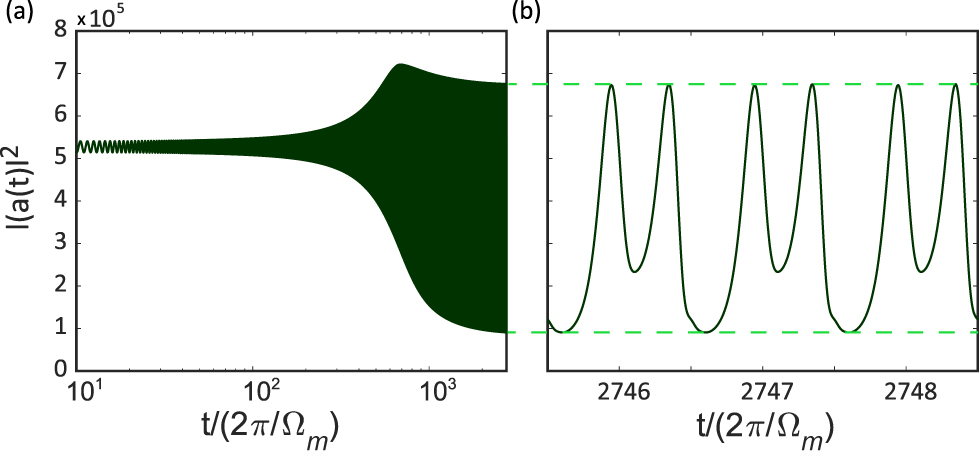
(a) Simulated self-induced oscillations showing the evolution of the intracavity photons versus time in logarithmic scale. (b) Close view of the saturated oscillation with a stable amplitude corresponding to the optical traces of the optical frequency comb (OFC).
The experimental traces were acquired by photodetecting the transmitted optical signal via a high-speed and high-sensitivity photoreceiver whilst the reflected signal was used to trigger the waveform in a high-speed oscilloscope (for more details about the experimental setup see Supplementary material). Both, the theoretical and experimental temporal traces are presented in Figure 7 for different laser wavelengths – corresponding to different detunings – and input photon fluxes
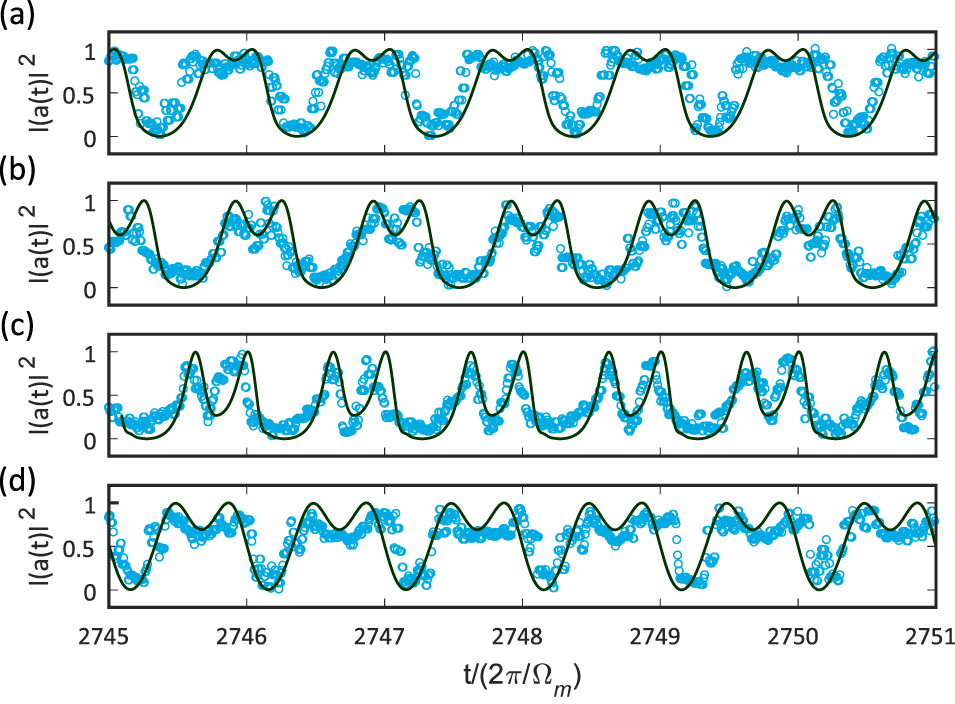
Comparison of the experimental (blue dots) and theoretical (solid line) temporal optomechanical (OM)-generated optical frequency comb (OFC) traces under different experimental conditions.
(a)
The remaining cavity parameters required in the theoretical model were obtained from the simulation of the fabricated structure. In particular, we used a mechanical zero-point fluctuation amplitude
5 Conclusions
In summary, we have demonstrated a novel silicon OM crystal cavity that exhibits a large OM coupling rate for a GHz mode within a full phononic bandgap. We have shown that this OM cavity can perform as an ultracompact OMO at a microwave frequency around 4 GHz working at room temperature. Notice that our device is a free-running or open-loop OMO: the device generates an RF tone and there is no any feedback loop to improve the frequency stabilization. Operating at cryogenic temperatures would enormously improve the phase noise [46] as a result of the enhancement of the mechanical Q factor because of the full phononic bandgap [22]. This would also allow us to discern if the phononic bandgap plays a role in the better performance in terms of phase noise in comparison to the OM crystal reported in a study by Ghorbel et al. [12]. Tunability of the resulting microwave signal could be achieved by injection locking to an external optically modulated tone [47]. In addition, the preliminary demonstration of the OFC paves the way toward synthesis of microwave signals beyond the generation of pure continuous wave tones. The main advantages of the OM cavity approach for RF and microwave signal processing are its extreme compactness and low weight, highly desirable in space and satellite applications, as well as its compatibility with silicon electronics and photonics technology. The resulting optomechanically generated OFC could also be useful in sensing and spectroscopy applications by taking profit of the small distance between comb lines which would enable detection using standard electronic equipment. We also envisage that this new OM cavity could be useful in quantum applications since the mechanical Q factor can be extremely increased in cryogenic environments [48].
Funding source: European Commission
Award Identifier / Grant number: PHENOMEN H2020-EU-713450
Funding source: Programa de Ayudas de Investigación y Desarrolo de la Universitat Politècnica de València
Award Identifier / Grant number: PAID-01-16
Funding source: Ministerio de Ciencia, Innovación y Universidades
Award Identifier / Grant number: PGC2018-094490-B
Award Identifier / Grant number: PRX18/00126
Funding source: Generalitat Valenciana
Award Identifier / Grant number: PROMETEO/2019/123
Award Identifier / Grant number: PPC/2018/002
Award Identifier / Grant number: IDIFEDER/2018/033
Acknowledgment
The authors thank Borja Vidal and Miguel A. Piqueras for technical support. L. M. would like to thank M.-A. Miri for helpful comments.
Author contribution: All the authors have accepted responsibility for the entire content of this submitted manuscript and approved submission.
Research funding: This work was supported by the European Commission (PHENOMEN H2020-EU-713450); Programa de Ayudas de Investigación y Desarrolo (PAID-01-16) de la Universitat Politècnica de València; Ministerio de Ciencia, Innovación y Universidades (PGC2018-094490-B, PRX18/00126) and Generalitat Valenciana (PROMETEO/2019/123, PPC/2018/002, IDIFEDER/2018/033).
Conflict of interest statement: The authors declare no conflicts of interest regarding this article.
References
[1] T. J. Kippenberg and K. J. Vahala, “Cavity optomechanics: back-action at the mesoscale,” Science, vol. 321, no. 5893, pp. 1172–1176, 2008. https://doi.org/10.1126/science.1156032.Search in Google Scholar
[2] M. Aspelmeyer, T. J. Kippenberg, and F. Marquardt, “Cavity optomechanics,” Rev. Mod. Phys., vol. 86, no. 4, pp. 1391–1452, 2014. https://doi.org/10.1103/revmodphys.86.1391.Search in Google Scholar
[3] J. Chan, T. P. Alegre, A. H. Safavi-Naeini, et al., “Laser cooling of a nanomechanical oscillator into its quantum ground state,” Nature, vol. 478, no. 7367, pp. 89–92, 2011. https://doi.org/10.1038/nature10461.Search in Google Scholar
[4] I. S. Grudinin, A. B. Matsko, and L. Maleki, “Brillouin lasing with a CaF2 whispering gallery mode resonator,” Phys. Rev. Lett., vol. 102, no. 4, p. 043902, 2009. https://doi.org/10.1103/physrevlett.102.043902.Search in Google Scholar
[5] I. S. Grudinin, H. Lee, O. Painter, and K. J. Vahala, “Phonon laser action in a tunable two-level system,” Phys. Rev. Lett., vol. 104, no. 8, p. 083901, 2010. https://doi.org/10.1103/physrevlett.104.083901.Search in Google Scholar
[6] S. Weis, R. Rivière, S. Deléglise, et al., “Optomechanically induced transparency,” Science, vol. 330, no. 6010, pp. 1520–1523, 2010. https://doi.org/10.1126/science.1195596.Search in Google Scholar
[7] A. H. Safavi-Naeini, T. P. Mayer Alegre, J. Chan, et al., “Electromagnetically induced transparency and slow light with optomechanics,” Nature, vol. 472, no. 7341, pp. 69–73, 2011. https://doi.org/10.1038/nature09933.Search in Google Scholar
[8] F. Ruesink, M. A. Miri, A. Alù, and E. Verhagen, “Nonreciprocity and magnetic-free isolation based on optomechanical interactions,” Nat. Commun., vol. 7, no. 1, p. 13662, 2016. https://doi.org/10.1038/ncomms13662.Search in Google Scholar
[9] M. Eichenfield, J. Chan, R. M. Camacho, K. J. Vahala, and O. Painter, “Optomechanical crystals,” Nature, vol. 462, no. 7269, pp. 78–82, 2009. https://doi.org/10.1038/nature08524.Search in Google Scholar
[10] J. Capmany and D. Novak, “Microwave photonics combines two worlds,” Nat. Photon., vol. 1, no. 6, pp. 319–330, 2007. https://doi.org/10.1038/nphoton.2007.89.Search in Google Scholar
[11] M. Hossein-Zadeh and K. J. Vahala, “Photonic RF down-converter based on optomechanical oscillation,” IEEE Photon. Technol. Lett., vol. 20, no. 4, pp. 234–236, 2008. https://doi.org/10.1109/lpt.2007.912991.Search in Google Scholar
[12] I. Ghorbel, R. Zhu, D. Dolfi, et al., “Optomechanical gigahertz oscillator made of a two photon absorption free piezoelectric III/V semiconductor,” APL Photon., vol. 4, no. 11, p. 116103, 2019. https://doi.org/10.1063/1.5121774.Search in Google Scholar
[13] T. J. Kippenberg, H. Rokhsari, T. Carmon, A. Scherer, and K. J. Vahala, “Analysis of radiation-pressure induced mechanical oscillation of an optical microcavity,” Phys. Rev. Lett., vol. 95, no. 3, p. 033901, 2005. https://doi.org/10.1103/physrevlett.95.033901.Search in Google Scholar
[14] T. Carmon, H. Rokhsari, L. Yang, T. J. Kippenberg, and K. J. Vahala, “Temporal behavior of radiation – pressure-induced vibrations of an optical microcavity phonon mode,” Phys. Rev. Lett., vol. 94, no. 22, p. 223902, 2005. https://doi.org/10.1103/physrevlett.94.223902.Search in Google Scholar
[15] M.-A. Miri, G. D’Aguanno, and A. Alú, “Optomechanical frequency combs,” New J. Phys., vol. 20, no. 4, p. 043013, 2018. https://doi.org/10.1088/1367-2630/aab5c6.Search in Google Scholar
[16] V. Torres-Company and A. M. Weiner, “Optical frequency comb technology for ultra-broadband radiofrequency photonics,” Laser Photon. Rev., vol. 8, no. 3, pp. 368–393, 2014. https://doi.org/10.1002/lpor.201300126.Search in Google Scholar
[17] J. Chan, A. H. Safavi-Naeini, J. T. Hill, S. Meenehan, and O. Painter, “Optimized optomechanical crystal cavity with acoustic radiation shield,” Appl. Phys. Lett., vol. 101, no. 8, p. 081115, 2012. https://doi.org/10.1063/1.4747726.Search in Google Scholar
[18] Y. Pennec, B. Djafari Rouhani, C. Li, et al., “Band gaps and cavity modes in dual phononic and photonic strip waveguides,” AIP Adv., vol. 1, no. 4, p. 041901, 2011. https://doi.org/10.1063/1.3675799.Search in Google Scholar
[19] A. G. Krause, J. T. Hill, M. Ludwig, et al., “Nonlinear radiation pressure dynamics in an optomechanical crystal,” Phys. Rev. Lett., vol. 115, no. 23, p. 233601, 2015. https://doi.org/10.1103/physrevlett.115.233601.Search in Google Scholar
[20] L. Qiu, I. Shomroni, P. Seidler, and T. J. Kippenberg, “High-fidelity laser cooling to the quantum ground state of a silicon nanomechanical oscillator,” 2019, arXiv: 1903.10242 [quant-ph].Search in Google Scholar
[21] K. Fang, M. H. Matheny, X. Luan, and O. Painter, “Optical transduction and routing of microwave phonons in cavity-optomechanical circuits,” Nat. Photon., vol. 10, p. 489, 2016. https://doi.org/10.1038/nphoton.2016.107.Search in Google Scholar
[22] G. S. MacCabe, H. Ren, J. Luo, et al., “Phononic bandgap nanoacoustic cavity with ultralong phonon lifetime,” 2019, arXiv: 1901.04129 [cond-mat.mes-hall].Search in Google Scholar
[23] J. Gomis-Bresco, D. Navarro-Urrios, M. Oudich, et al., “A one-dimensional optomechanical crystal with a complete phononic band gap,” Nat. Commun., vol. 5, no. 1, p. 4452, 2014. https://doi.org/10.1038/ncomms5452.Search in Google Scholar
[24] D. Navarro-Urrios, N. E. Capuj, J. Gomis-Bresco, et al., “A self-stabilized coherent phonon source driven by optical forces,” Sci. Rep., vol. 5, p. 15733, 2015. https://doi.org/10.1038/srep15733.Search in Google Scholar
[25] D. Navarro-Urrios, N. E. Capuj, M. F. Colombano, et al., “Nonlinear dynamics and chaos in an optomechanical beam,” Nat. Commun., vol. 8, no. 1, p. 14965, 2017. https://doi.org/10.1038/ncomms14965.Search in Google Scholar
[26] M. F. Colombano, G. Arregui, N. E. Capuj, et al., “Synchronization of optomechanical nanobeams by mechanical interaction,” Phys. Rev. Lett., vol. 123, no. 1, p. 017402, 2019. https://doi.org/10.1103/physrevlett.123.017402.Search in Google Scholar
[27] M. Oudich, S. El-Jallal, Y. Pennec, et al., “Optomechanic interaction in a corrugated phoxonic nanobeam cavity,” Phys. Rev. B, vol. 89, no. 24, p. 245122, 2014. https://doi.org/10.1103/physrevb.89.245122.Search in Google Scholar
[28] L. Maleki, “The optoelectronic oscillator,” Nat. Photon., vol. 5, no. 12, pp. 728–730, 2011. https://doi.org/10.1038/nphoton.2011.293.Search in Google Scholar
[29] X. S. Yao and L. Maleki, “Optoelectronic microwave oscillator,” J. Opt. Soc. Am. B, vol. 13, no. 8, pp. 1725–1735, 1996. https://doi.org/10.1364/josab.13.001725.Search in Google Scholar
[30] J. Li, H. Lee, and K. J. Vahala, “Microwave synthesizer using an on-chip Brillouin oscillator,” Nat. Commun., vol. 4, no. 1, p. 2097, 2013. https://doi.org/10.1038/ncomms3097.Search in Google Scholar
[31] R. Van Laer, R. Baets, and D. Van Thourhout, “Unifying Brillouin scattering and cavity optomechanics,” Phys. Rev. A, vol. 93, no. 5, p. 053828, 2016. https://doi.org/10.1103/physreva.93.053828.Search in Google Scholar
[32] D. Navarro-Urrios, J. Gomis-Bresco, S. El-Jallal, et al., “Dynamical back-action at 5.5 GHz in a corrugated optomechanical beam,” AIP Adv., vol. 4, no. 12, p. 124601, 2014. https://doi.org/10.1063/1.4902171.Search in Google Scholar
[33] F. Pan, K. Cui, G. Bai, et al., “Radiation-pressure-antidamping enhanced optomechanical spring sensing,” ACS Photon., vol. 5, no. 10, pp. 4164–4169, 2018. https://doi.org/10.1021/acsphotonics.8b00968.Search in Google Scholar
[34] S. Tallur, S. Sridaran, S. A. Bhave, and T. Carmon, “Phase noise modeling of opto-mechanical oscillators,” in 2010 IEEE International Frequency Control Symposium, 2010, pp. 268–272.10.1109/FREQ.2010.5556330Search in Google Scholar
[35] S. Tallur, S. Sridaran, and S. A. Bhave, “A monolithic radiation-pressure driven, low phase noise silicon nitride opto-mechanical oscillator,” Opt. Express, vol. 19, no. 24, pp. 24522–24529, 2011. https://doi.org/10.1364/oe.19.024522.Search in Google Scholar
[36] E. Rubiola, Phase Noise and Frequency Stability in Oscillators. The Cambridge RF and Microwave Engineering Series, Cambridge, England: Cambridge University Press, 2008.10.1017/CBO9780511812798Search in Google Scholar
[37] https://www.keysight.com/us/en/assets/7018-08250/datasheets/5989-7572.pdf.Search in Google Scholar
[38] S. Sridaran and S. A. Bhave, “1.12 GHz opto-acoustic oscillator,” in 2012 IEEE 25th International Conference on Micro Electro Mechanical Systems (MEMS), 2012, pp. 664–667.10.1109/MEMSYS.2012.6170274Search in Google Scholar
[39] X. Luan, Y. Huang, Y. Li, et al., “An integrated low phase noise radiation-pressure-driven optomechanical oscillator chipset,” Sci. Rep., vol. 4, p. 6842, 2014. https://doi.org/10.1038/srep06842.Search in Google Scholar
[40] M. S. Kang, A. Nazarkin, A. Brenn, and P. S. J. Russell, “Tightly trapped acoustic phonons in photonic crystal fibres as highly nonlinear artificial Raman oscillators,” Nat. Phys., vol. 5, no. 4, pp. 276–280, 2009. https://doi.org/10.1038/nphys1217.Search in Google Scholar
[41] P. Del’Haye, A. Schliesser, O. Arcizet, T. Wilken, R. Holzwarth, and T. J. Kippenberg, “Optical frequency comb generation from a monolithic microresonator,” Nature, vol. 450, no. 7173, pp. 1214–1217, 2007. https://doi.org/10.1038/nature06401.Search in Google Scholar
[42] T. J. Kippenberg, R. Holzwarth, and S. A. Diddams, “Microresonator-based optical frequency combs,” Science, vol. 332, no. 6029, pp. 555–559, 2011. https://doi.org/10.1126/science.1193968.Search in Google Scholar
[43] A. A. Savchenkov, A. B. Matsko, V. S. Ilchenko, D. Seidel, and L. Maleki, “Surface acoustic wave optomechanical oscillator and frequency comb generator,” Opt. Lett., vol. 36, no. 17, pp. 3338–3340, 2011. https://doi.org/10.1364/ol.36.003338.Search in Google Scholar
[44] A. H. Safavi-Naeini, D. Van Thourhout, R. Baets, and R. Van Laer, “Controlling phonons and photons at the wavelength scale: integrated photonics meets integrated phononics,” Optica, vol. 6, no. 2, pp. 213–232, 2019. https://doi.org/10.1364/optica.6.000213.Search in Google Scholar
[45] D. Navarro-Urrios, J. Gomis-Bresco, N. E. Capuj, et al., “Optical and mechanical mode tuning in an optomechanical crystal with light-induced thermal effects,” J. Appl. Phys., vol. 116, no. 9, p. 093506, 2014. https://doi.org/10.1063/1.4894623.Search in Google Scholar
[46] M. Hossein-Zadeh and K. J. Vahala, “An optomechanical oscillator on a silicon chip,” IEEE J. Sel. Top. Quant. Electron., vol. 16, no. 1, pp. 276–287, 2010. https://doi.org/10.1109/jstqe.2009.2031066.Search in Google Scholar
[47] M. Hossein-Zadeh and K. J. Vahala, “Observation of injection locking in an optomechanical RF oscillator,” Appl. Phys. Lett., vol. 93, no. 19, p. 191115, 2008. https://doi.org/10.1063/1.3028024.Search in Google Scholar
[48] M. Mirhosseini, A. Sipahigil, M. Kalaee, and O. Painter, “Quantum transduction of optical photons from a superconducting qubit,” 2020, arXiv: 2004.04838 [quant-ph].Search in Google Scholar
Supplementary Material
The online version of this article offers supplementary material (https://doi.org/10.1515/nanoph-2020-0148).
© 2020 Laura Mercadé et al., published by De Gruyter, Berlin/Boston
This work is licensed under the Creative Commons Attribution 4.0 International License.
Articles in the same Issue
- Reviews
- Boron nitride for excitonics, nano photonics, and quantum technologies
- Design for quality: reconfigurable flat optics based on active metasurfaces
- Research Articles
- Microwave oscillator and frequency comb in a silicon optomechanical cavity with a full phononic bandgap
- Second harmonic generation in metasurfaces with multipole resonant coupling
- Symmetry-tailored patterns and polarizations of single-photon emission
- Highly transparent and conductive metal oxide/metal/polymer composite electrodes for high-efficiency flexible organic light-emitting devices
- Optical anapole mode in nanostructured lithium niobate for enhancing second harmonic generation
- Temporal plasmonics: Fano and Rabi regimes in the time domain in metal nanostructures
- Chemiluminescent carbon nanodots as sensors for hydrogen peroxide and glucose
- Dual-polarized multiplexed meta-holograms utilizing coding metasurface
- Tunable photoluminescence properties of selenium nanoparticles: biogenic versus chemogenic synthesis
- Compact disordered magnetic resonators designed by simulated annealing algorithm
- Controlling the plasmon resonance via epsilon-near-zero multilayer metamaterials
- 2D GeP-based photonic device for near-infrared and mid-infrared ultrafast photonics
- Purcell-enhanced emission from individual SiV− center in nanodiamonds coupled to a Si3N4-based, photonic crystal cavity
- Ultrasensitive and fast photoresponse in graphene/silicon-on-insulator hybrid structure by manipulating the photogating effect
- Multiresonant plasmonic nanostructure for ultrasensitive fluorescence biosensing
- Advanced encryption method realized by secret shared phase encoding scheme using a multi-wavelength metasurface
Articles in the same Issue
- Reviews
- Boron nitride for excitonics, nano photonics, and quantum technologies
- Design for quality: reconfigurable flat optics based on active metasurfaces
- Research Articles
- Microwave oscillator and frequency comb in a silicon optomechanical cavity with a full phononic bandgap
- Second harmonic generation in metasurfaces with multipole resonant coupling
- Symmetry-tailored patterns and polarizations of single-photon emission
- Highly transparent and conductive metal oxide/metal/polymer composite electrodes for high-efficiency flexible organic light-emitting devices
- Optical anapole mode in nanostructured lithium niobate for enhancing second harmonic generation
- Temporal plasmonics: Fano and Rabi regimes in the time domain in metal nanostructures
- Chemiluminescent carbon nanodots as sensors for hydrogen peroxide and glucose
- Dual-polarized multiplexed meta-holograms utilizing coding metasurface
- Tunable photoluminescence properties of selenium nanoparticles: biogenic versus chemogenic synthesis
- Compact disordered magnetic resonators designed by simulated annealing algorithm
- Controlling the plasmon resonance via epsilon-near-zero multilayer metamaterials
- 2D GeP-based photonic device for near-infrared and mid-infrared ultrafast photonics
- Purcell-enhanced emission from individual SiV− center in nanodiamonds coupled to a Si3N4-based, photonic crystal cavity
- Ultrasensitive and fast photoresponse in graphene/silicon-on-insulator hybrid structure by manipulating the photogating effect
- Multiresonant plasmonic nanostructure for ultrasensitive fluorescence biosensing
- Advanced encryption method realized by secret shared phase encoding scheme using a multi-wavelength metasurface

